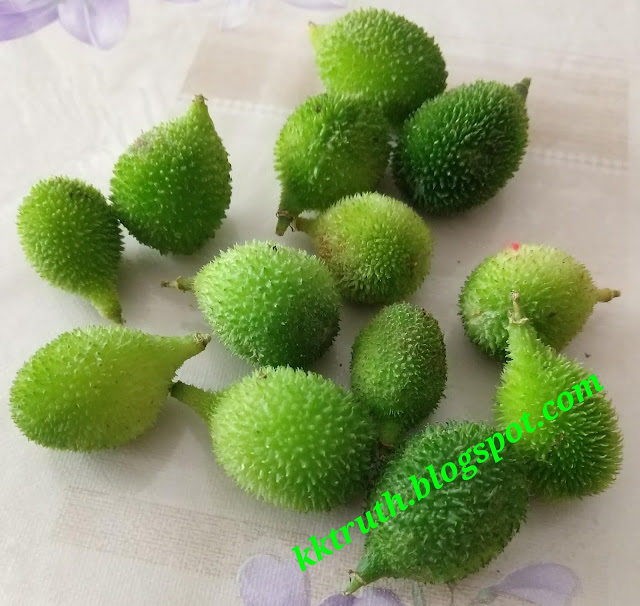 |
| The rare and costly vegetable - Khaksi, Konkari, Kantola The spine Gourd |
We shall talk about the smaller variety- Khaksi, also called Kantola or Konkari. It has a tuber root and also propagates through the root. It can also propagate through seeds. When the fruit is ripe, the inside becomes red. Every year, the new plant grows from the roots in the ground. It grows itself every year in the Jungle in the rainy season. The village people near the Jungle collect it and send it to the market to sell at a high price. Since it is not frequently available in the market, many people may not know about it, but this is originally an Indian vegetable because there is a reference to it in traditional religious stories of the "Madhushrawani". It is also offered to Mahadev (Shiva) in this puja. {"Madhushrawani" puja is a thirteen-day puja in the Mithila region of Bihar, in which a newly married bride (Married within a year) worships Shiva and Parwati in the first fortnight of the Hindu month of Sawan (Sawan ke pahle Paksh me). Every day, she hears some stories that are told by an elderly lady. These stories are called "Madhushrawani Katha". These folk stories were traditionally transferred to the next generation through hearing only, but now these storybooks are also available in the market. Even on Amazon.}
Since it is mostly collected from the Jungles, it is almost organic. No fertilizers and no pesticides. It is also very good for health and for diabetic people. The Khaksi recipe is mostly prepared as fried Khaksi (Khaksi ka Bhujiya). It is very simple to prepare.
 |
| Khaksi, Kantola fry recipe |
===<<<O>>>==
Thoughts Unlimited
INDEX
34. रवि की दिलेरी
30. How to type superscript and subscript in Blogger?
29. Was the lockdown announced by PM necessary for checking COVID-19? क्या लॉकडाउन जरुरी था?
28. Giloy, Guduchi, Gurich, Amrita - Traditional Ayurvedic Medicine
27. Monkey fruit -- Barhar, badahal
26. Mahua
25. Never bargain with a farmer
24. Ganda (गंडा) - a forgotten unit
23. Totka - Kale Ghode ki Naal - Earning from superstitions
22. Tikhur - The East Indian Arrowroot
21. Birdwatch - Swift, Swiftlets
29. Was the lockdown announced by PM necessary for checking COVID-19? क्या लॉकडाउन जरुरी था?
28. Giloy, Guduchi, Gurich, Amrita - Traditional Ayurvedic Medicine
27. Monkey fruit -- Barhar, badahal
26. Mahua
25. Never bargain with a farmer
24. Ganda (गंडा) - a forgotten unit
23. Totka - Kale Ghode ki Naal - Earning from superstitions
22. Tikhur - The East Indian Arrowroot
21. Birdwatch - Swift, Swiftlets
18. Never buy a cheap Geyser
17. Washing Machine - Semi-automatic or Fully-automatic
16. Chicory and Coffee
15. Khaksa, Khaksi, Konkari- The smaller Spine gourd - Food Blog
14. Rugra, (रुगड़ा), Phutka, Puttu - A type of mushroom - vegetable - Food Blog.
13. Jatadhari Bull - जटावाले ऋषभ (सांड़)
17. Washing Machine - Semi-automatic or Fully-automatic
16. Chicory and Coffee
15. Khaksa, Khaksi, Konkari- The smaller Spine gourd - Food Blog
14. Rugra, (रुगड़ा), Phutka, Puttu - A type of mushroom - vegetable - Food Blog.
13. Jatadhari Bull - जटावाले ऋषभ (सांड़)
===<<<O>>>===

No comments:
Post a Comment